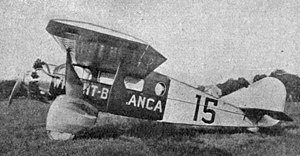The Wright-Bellanca WB-1 was designed by Giuseppe Mario Bellanca for the Wright Aeronautical corporation for use in record-breaking flights.[2]
| WB-1 | |
|---|---|

| |
| Role | Cabin monoplane |
| National origin | United States |
| Manufacturer | Wright-Bellanca[1] |
| Designer | Giuseppe Mario Bellanca |
| First flight | September 1925 |
| Number built | 1 |
Development
editThe WB-1 was a high-winged monoplane with conventional landing gear and all-wood construction. The landing gear fairings were constructed to extend into wheel pants.[3][4]
Operational history
editThe WB-1 was demonstrated at the 1925 Pulitzer Prize Air Races in New York. In the first day's flights, the WB-1 clocked in 121.8 mph in a closed course race. On day two, the WB-1 won, in a payload versus hp and speed efficiency contest, beating a Curtiss Oriole and Sikorsky S-31. In 1926, pilot Fred Becker crashed the overloaded aircraft in a world-record endurance attempt. The aircraft cartwheeled and broke up on a landing attempt.[5][6]
Specifications (WB-1)
editGeneral characteristics
- Crew: 1
- Capacity: 5 (1,440 lb (650 kg))
- Length: 24 ft 9 in (7.54 m)
- Wingspan: 45 ft (14 m)
- Powerplant: 1 × Wright J-4 Whirlwind 9-cyl. air-cooled radial piston engine, 200 hp (150 kW)
- Propellers: 2-bladed
Performance
- Maximum speed: 115 kn (132 mph, 212 km/h)
- Cruise speed: 87 kn (100 mph, 160 km/h)
- Stall speed: 39 kn (45 mph, 72 km/h)
See also
editRelated development
References
edit- ^ "Air and Space Giuseppe M. Bellanca Collection". Archived from the original on 30 June 2016. Retrieved 29 September 2013.
- ^ Jackson, Joe (30 April 2013). Atlantic fever : Lindbergh, his competitors, and the race to cross the Atlantic (First Picadorition ed.). Picador. p. 127. ISBN 978-1250033307.
- ^ "Part 1". Pilot. 13: 35.
- ^ Smyth, Ross (1 September 1997). The Lindbergh of Canada : the Erroll Boyd story. General Store Pub. p. 63. ISBN 978-1896182612.
- ^ Gough, Michael (3 May 2013). The Pulitzer air races : American aviation and speed supremacy, 1920-1925. McFarland & Company. p. 175. ISBN 978-0786471003.
- ^ Spenser, Jay P. (17 June 1982). Bellanca C.F. : the emergence of the cabin monoplane in the United States. Published for the National Air and Space Museum by the Smithsonian Institution Press. p. 45. ISBN 978-0874748819.
- ^ "Air and Space". Air Pictorial. 1975.
- ^ Eckland, K.O. "Wright". aerofiles.com. Retrieved 13 November 2018.